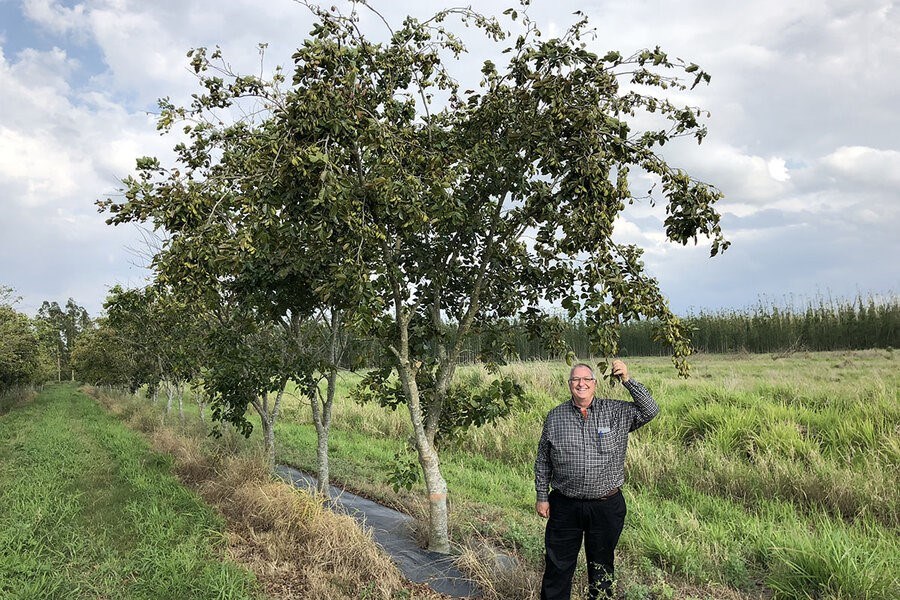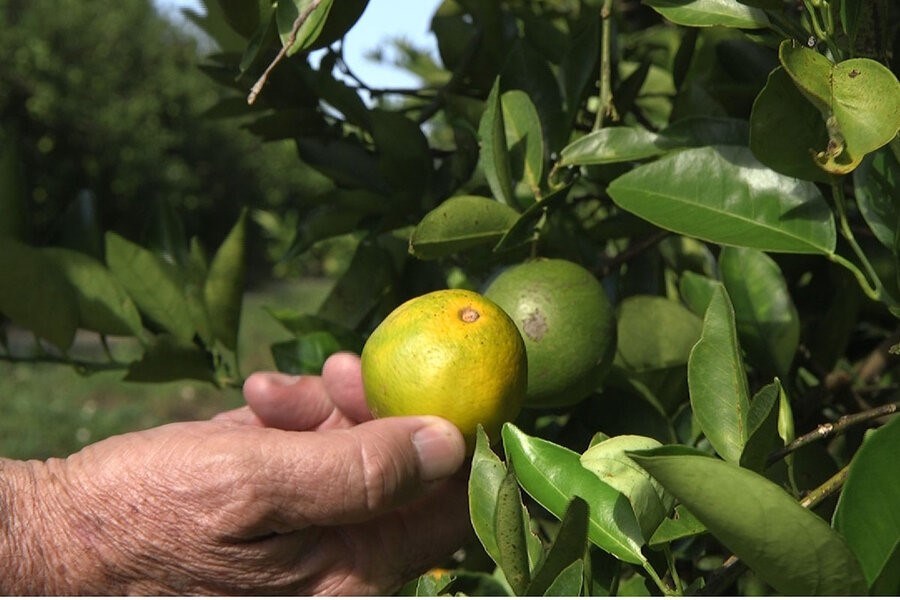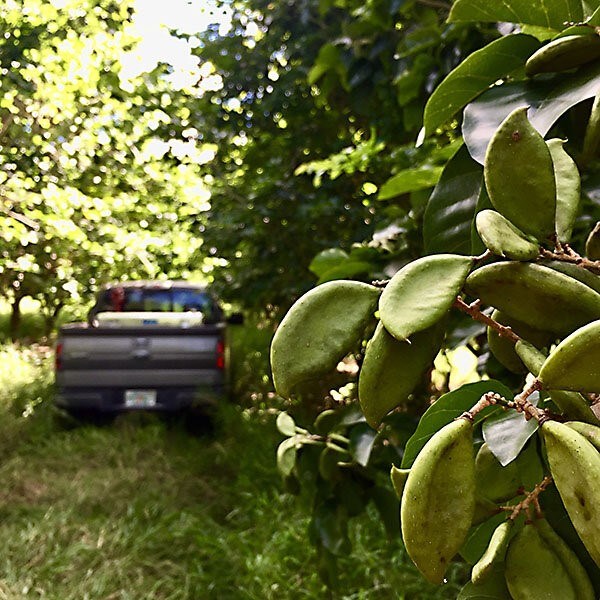REPRINTED WITH PERMISSION FROM THE CHRISTIAN SCIENCE MONITOR
 Citrus expert Peter McClure stands underneath a pongamia tree in a Florida orchard. Some farmers are trying this hardy tree- which can be used for oils, a soybeanlike protein source, or fertilizer feedstock- as a replacement for declining citrus crops. Courtesy of Terviva
Citrus expert Peter McClure stands underneath a pongamia tree in a Florida orchard. Some farmers are trying this hardy tree- which can be used for oils, a soybeanlike protein source, or fertilizer feedstock- as a replacement for declining citrus crops. Courtesy of Terviva
March 2, 2023
Every spring, the sweet smell of citrus blossoms permeates the air on the Estes family farm in Vero Beach, Florida. The family has grown and harvested citrus on this land for more than a century.
“The smell used to filter into town,” the farm’s third-generation owner Cody Estes says, smiling.
But despite their heritage and deep connection to the industry, Mr. Estes doubts he’ll ever plant another citrus tree in the groves. Eventually, his family’s plan is to leave Florida’s $6.5 billion industry to invest in a new, imported crop, much as citrus was before European colonizers brought the Asia-derived fruit to North American shores. Anything else he puts in the ground, Mr. Estes says, will be a tree called pongamia.
The citrus industry, long a defining symbol of Florida, is facing an existential crisis due to a plant disease that arrived in the state in 2005 and has spread to affect 80% of the orange groves. In 2004, Florida had an estimated 7,000 growers. Today, there are about 2,000. If the latest estimates hold, the state’s current growing season will yield 61% less fruit than last season, partly due to hurricane effects.
The Estes family’s most productive trees have been cut down and burned.
Back at his office, Mr. Estes leans back in a chair and crosses his hands over his chest. Years after the arrival of what’s called citrus greening disease, “we really don’t have a good answer,” he says.
What he does have is a willingness to adapt. He and other farmers aim to chart a path of ingenuity that can keep agriculture – and its livelihood for workers – in the state. To do that, a first step is to prove that new crops like pongamia fulfill their promise.
“The alarm bells were rung”
In 2005, Michael Rogers felt the citrus industry shake beneath his feet. Mr. Rogers, director of the University of Florida’s Citrus Research and Education Center, was sitting in a meeting with a large citrus processing company when he felt his phone buzz in his pocket. A text from a colleague read, “It’s here.”
Mr. Rogers texted back, “What’s here?”
The colleague replied, “HLB.”
 Federica Narancio/APA University of Florida citrus researcher holds an orange affected by citrus greening disease at a grove in Fort Meade, Florida, on Sept. 27, 2018. Scientists have been exploring ways of combatting the disease.
Federica Narancio/APA University of Florida citrus researcher holds an orange affected by citrus greening disease at a grove in Fort Meade, Florida, on Sept. 27, 2018. Scientists have been exploring ways of combatting the disease.
Huanglongbing, or citrus greening, has been documented in China for at least a century, but it hadn’t reached the Western Hemisphere’s shores until 2004, when it was recorded in Brazil – the world’s leading citrus producer. Prior to greening’s arrival, the pathogen was so feared that the U.S. Department of Agriculture classified it as a potential bioterrorism weapon that could be used against the nation’s agricultural sector.
“The alarm bells were rung very loudly,” Mr. Rogers says. “It’s like one of those moments where everybody knows where they were when they heard the news.”
In the ensuing years, some headway has been made in understanding the role of bacteria in citrus greening.
Growers rethought fertilization techniques, as well as how – and when – they irrigate crops, with water pumps that have features such as moisture sensors. In the estimate of Jim Hoffman, Estes Citrus’ production manager and an industry veteran of two decades, the fight against greening’s effects has made more efficient farmers through their increased attentiveness to the health of groves and new technologies.
“We’re more purposeful with our resources,” Mr. Hoffman says. “We’re farming smarter.”
A protein-rich, hardy alternative
Ideas for new crops have arisen as farmers try to keep the land in use, such as blueberries, cotton, alfalfa, eucalyptus, and sugar beets. Polk County citrus growers Henry Hooker and his sister Deborah Hooker partnered with the HBCU Florida A&M University and Green Earth Cannaceuticals to grow legal hemp.
But pongamia carries the most promise so far, says Peter McClure, whose family’s roots in Florida citrus date to the seedlings his great-grandparents planted in Orange County in 1868. Mr. McClure is also the chief agriculture officer at Terviva, the California startup helping lead pongamia’s commercialization through partnerships with farmers like Mr. Estes.
In India, Australia, and parts of southeast Asia, pongamia grows wild as it bears little beanlike pods that, in India, are crushed and used for lamp oil. Terviva hopes to corner the tree’s American market; their plan, use it for biofuel production, fertilizer feedstock, and a more sustainable alternative to soybeans for protein.
Like citrus, pongamia grows in Florida’s unforgiving sandy soil. Unlike citrus, though, pongamia is mostly pest-resistant, has a lower cost of production, is drought-resistant, and can withstand wet conditions, and it requires minimal inputs. In fact, it requires a fraction of the irrigation necessary to keep citrus trees healthy. And unlike labor-intensive citrus, the pongamia can be harvested using a mechanized shaker.
It’s also how Mr. Estes and Mr. McClure found themselves working together.
Just like citrus soared in the economic boom that followed World War II, they envision a potential pongamia boom today, helping to meet the rising demand for climate-friendly agriculture.
 Courtesy of TervivaPongamia beans are harvested from trees. Florida citrus farmers have begun replacing their dying citrus orchards with the species.
Courtesy of TervivaPongamia beans are harvested from trees. Florida citrus farmers have begun replacing their dying citrus orchards with the species.
“With pongamia, we have a different confluence of factors,” Mr. McClure says of their goals. “Huge numbers of people in Asia are becoming affluent. When you become affluent, you want more protein.”
Mr. McClure adds, “North America’s plowed up. Asia’s plowed up. To feed the next 3 billion people, you’d have plow up the Amazon and Africa, which isn’t a good idea. That’s where pongamia comes in.”
Mr. Estes’ pongamia groves are four years or so away from production. They expect the trees’ output to max out as a mature crop around the time each tree reaches its eighth year.
The pongamia crop “holds the promise that we can continue farming, provide for our families, and leave a gentle footprint on the land,” says Mr. Hoffman, the Estes Citrus manager.
Wrestling with uncertainty
In September, Hurricane Ian rolled over southwest Florida, surging with 4 feet of water into homes in North Fort Myers. It also affected citrus farmers in Desoto, Hardee, and Polk counties (though dodging Indian River County where Mr. Estes lives). Some crops were reported as a total loss – a severe blow to an already struggling industry.
Government can only aid their industry for so long. Measures like a box tax that funds research about citrus greening may help. If nothing else, some farmers hope to find an alternative so they can pass the land along to family, rather than sell the land to developers that will pave it over.
As his children grew up, Mr. Estes steered them away from the family citrus business, because it’s so difficult to make a living. But he wants to keep their land alive for his grandchildren. He hopes they’ll follow him into pongamia.
Citrus equates to family for Mr. Estes. Asked whether removing the citrus trees his grandfather planted 45 years ago feels like a turning of the page, he takes his time. A sly half-smile sneaks across his face.
“I often wish that he was still here to debate some of the issues,” he says. “It takes decades to have enough experience to know what you think will work, and it’s not something you can just learn from a book – or learn from a year or two of experience.”
Mr. Estes opens the door of his truck and climbs outside. He’s standing in front of what, someday, will be the beginning of the farm’s pongamia grove. The trees are still young and shrubby. Estes looks at the trees and then back out at the dying groves around him.
He puts his hands on his hips, turns around and says, “It just really feels like it’s going to work.”
Related stories
Page created on 3/6/2023 10:10:10 PM
Last edited 3/6/2023 10:21:05 PM
